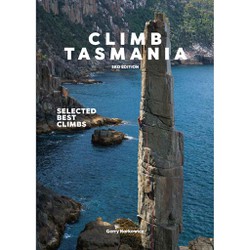description
The furthest buttress on the left (looking from camp). Skipping the first pitch makes for a much friendlier introduction to Tyndalls climbing.
Approach via the slabs and gullies along the cliff edge. You’ll come to a deep, scrubby gully which is crossed via a tight trail through the scrub (should be marked by a cairn).
Working your way along, you’ll probably find yourself on the summit of the tallest buttress. Looking down, you’ll see a big cairn on the ledge below you - this is where the rap starts. Walk lookers left a little bit to scramble down to this ledge.
Raps: - short one onto DBB at arete - straight down onto grassy ledge (don’t follow the line of the route here). You should see the next anchors down a little bit, on a lower ledge climbers right of the grassy one. - from here, follow the route.
The raps can be done on a 70m (with stretch). Alternatively, there’s a double FH belay halfway down P3 that can facilitate shorter ropes.
23m (23)
27m (16)
42m (19)
17m (18)
15m (16) - traverse and down climb a bit, aiming for the arete to climber’s right
27m (21)
14m (10)
Route history
There is no known route history.
Warnings
Location
- Lat/Lon: -41.93852, 145.60971
Grade citation
| 23 | Assigned grade |
| ★★★private | |
| ★★★private | |
| 23 | Gareth Llewellin |
| 23 [22 - 24] | grAId |
ethic
Crag Stewards
Many Tasmanian climbing areas have Stewards assigned as a point of contact for safety or access concerns.
For more details and the list of Steward emails please visit: http://www.thesarvo.com/confluence/display/thesarvo/Introduction+to+Tasmanian+Climbing
Statewide Ethics
The operation and use of drones by park visitors on reserved land including national parks is not permitted
Peregrine Falcons nest from July - December each year. It’s important that climbers don’t climb near active nests during this period. Known sites (non exhaustive) are: Sand River (Far East, The Panopticon), Bare Rock (R of the Boneyard, L of Bisso of Orange), Rocky Cape, Pubic Wall/Duck Reach, Hillwood, Gunners Quoin, Lowdina.
Please note that Tasmania has notoriously patchy phone reception for particular service providers. Telstra is the most reliable. An emergency Personal Locator Beacon or similar is recommended kit when climbing in remote locations.
For more information - follow the link below for some local tips + tricks on how to better reduce your impact during your next Tassie climbing holiday
Seasonality
Quality
Overall quality 70 from 20 ratings.
Difficulty - 23
Based on 3 ratings.
Suggested Grade
Based on 3 ratings.
Tick Types
Comment keywords
Selected Guidebooks more Hide
Author(s): Gerry Narkowicz
Date: 2021
ISBN: 9780646841946
Cracks, sea stacks, big walls, remote exotic locations, volcanic columns, no crowds and your choice of the predominant dolerite, some quartzite and a little sandstone to remind you of the mainland. Many a wilderness climbing experience can be had within a 2hr car trip from the main centers. By Gerry Narkowicz. This guide features 1280 routes.
Accommodations nearby more Hide
Share this
Get a detailed insight with a timeline showing
- Ticks by climbers like you
- Discussions of the community
- Updates to the index by our users
- and many more things.
Login to see the timeline!


